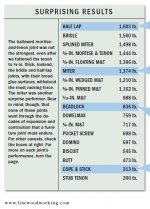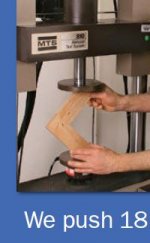As a former picture framer, I can attest to the fact that miters will fail over time from just the seasonal movement.
In most cases, when I was asked to re-frame a failed miter frame, the joints were glue starved. But nonetheless, there are no stresses placed on the joints, and still the miters failed.
The wider the molding, the more likely that seasonal movement will make the joint fail.
I use miters on my kitchen cabinet doors, with two dowels per corner. I prefer it because the painted joints look nicer.
But, I suspect that the reason miter joints will not ever be very popular is because you need to use twice as many bar clamps to clamp it.
Also, I question the data. I tested the picture framers’ standby glue, Corner Weld, against Woodworkers III. I made miter joints on 12” pieces of 3/4” x 1-1/2” poplar.
I only made three samples of each, with generous squeeze-out, but the results were highly consistent. Hanging barbell weights from the end of the miters all failed when I went from 50 pounds and jumped to 60 pounds.
The big difference between the glues was that Corner Weld started to setup in about 30 seconds, and you could handle the piece in about 5 minutes. If all you are doing is joining miters on an underpinner, then long open times are not necessary and are not your friend.
My results do not sound anything like their results. Keep in mind that you probably need a minimum of 10 to 20 samples and average out the results for the results to be meaningful.
I did only three samples. I was not looking for absolute results, only relative results.
When Corner Weld came out, I tested it against the industry standard back then, white glue. The Corner Weld was vastly stronger than white glue—nothing ambiguous about that. So three samples was fine to find a winner.
I really question the results.




